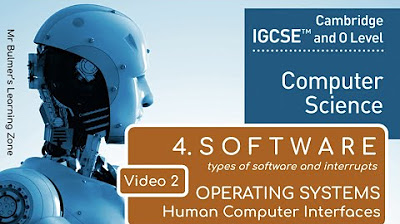CS101 Quiz 2_Fall 2023_Module 39-81_100% correct_CS101 quiz 2 solved_CS101 quiz 2 solution
Summary
TLDRThis video script offers an insightful breakdown of key concepts in computer science, networking, and operating systems. Topics covered include deadlock situations, algorithm development, networking protocols like HTTPS and NTP, and TCP/IP characteristics. The speaker explains essential concepts like flow control, critical sections, bit rotation, and the importance of protocol standards. Additionally, there are tips for midterm preparation with a focus on multiple-choice questions (MCQs) that will be featured in future quizzes. The content is designed to help students solidify their understanding of critical computer science topics.
Takeaways
- 😀 Deadlock occurs when two processes are waiting on each other’s resources, leading to a system-wide standstill.
- 😀 Repeated subtraction is a method for division, where repeatedly subtracting the divisor from the dividend helps identify the quotient and steps.
- 😀 Standardized styles like XMA and XML are essential in designing notational systems, particularly for data representation in computer science.
- 😀 Binary addition involves carrying over numbers to the next digit, ensuring that each place value is correctly calculated.
- 😀 HTTPS (HyperText Transfer Protocol Secure) is the protocol used for secure web communication, ensuring data integrity and confidentiality.
- 😀 Operating systems are responsible for protecting resources from unauthorized access, requiring the development of specific algorithms to manage this.
- 😀 CSMA/CA (Carrier Sense Multiple Access with Collision Avoidance) helps machines transmit messages over networks efficiently by waiting for a clear channel.
- 😀 Circular or rotational shifts move bits from one end of a binary number to the other, which is important for data manipulation in computing.
- 😀 A bridge in a network filters and forwards messages based on destination addresses, helping manage data flow and reduce network congestion.
- 😀 Task scaling involves dividing a task into sub-tasks that match the number of available processors, optimizing system efficiency.
Q & A
What is a deadlock in computing?
-A deadlock occurs when two or more processes are each waiting for the other to release resources, which prevents any of them from progressing.
How is binary addition performed, and what is the result when adding 5 repeatedly to 20 using subtraction?
-In binary addition, numbers are added step by step with carryovers. For the given problem, when repeatedly subtracting 5 from 20, we perform 4 steps, and the result of the subtraction is 0.
What is the purpose of the HTTPS protocol in a URL?
-HTTPS stands for HyperText Transfer Protocol Secure, and it ensures secure communication over a computer network by encrypting data during transmission.
What is the major responsibility of operating system software?
-The primary responsibility of an operating system is to protect resources from unauthorized access and manage resources efficiently.
In CSMA/CA, what action does a machine take if it finds the channel is silent?
-In CSMA/CA (Carrier Sense Multiple Access with Collision Avoidance), the machine waits for a predetermined time before transmitting to avoid collisions.
What is the difference between UDP and TCP?
-UDP (User Datagram Protocol) is more efficient but less reliable than TCP (Transmission Control Protocol), which provides reliable data transmission with error checking.
What is the main purpose of a bridge in a network?
-A bridge in a network filters and forwards messages based on their destination addresses, helping to connect different network segments.
What is circular or rotational shifting in data manipulation?
-Circular or rotational shifting involves moving bits that fall off one end of a binary number to the other end, effectively rotating the number.
Why are protocol standards essential in networking technology development?
-Protocol standards are crucial because they establish guidelines for vendors to create compatible products, ensuring interoperability between different systems and networks.
What is meant by critical region in process management?
-A critical region is a section of code or resource that can only be accessed by one process at a time to prevent conflicts and ensure data integrity.
Outlines

Esta sección está disponible solo para usuarios con suscripción. Por favor, mejora tu plan para acceder a esta parte.
Mejorar ahoraMindmap

Esta sección está disponible solo para usuarios con suscripción. Por favor, mejora tu plan para acceder a esta parte.
Mejorar ahoraKeywords

Esta sección está disponible solo para usuarios con suscripción. Por favor, mejora tu plan para acceder a esta parte.
Mejorar ahoraHighlights

Esta sección está disponible solo para usuarios con suscripción. Por favor, mejora tu plan para acceder a esta parte.
Mejorar ahoraTranscripts

Esta sección está disponible solo para usuarios con suscripción. Por favor, mejora tu plan para acceder a esta parte.
Mejorar ahoraVer Más Videos Relacionados

1.1 - Basic Elements of Computer & Computer System Architecture - Introduction - OS

INFORMATIKA KELAS X - SISTEM OPERASI - SISTEM KOMPUTER#kurikulummerdeka

Introduction to Primary Memory

KPPSC Computer Operator paper (06-04-2019) Complete solved: part 01

IGCSE Computer Science 2023-25 - SOFTWARE: Video 2 - THE OPERATING SYSTEM

Dasar dasar Informatika
5.0 / 5 (0 votes)
